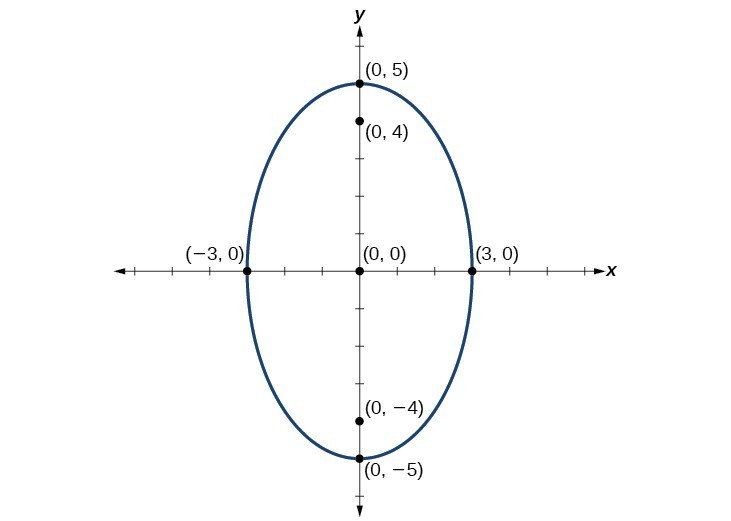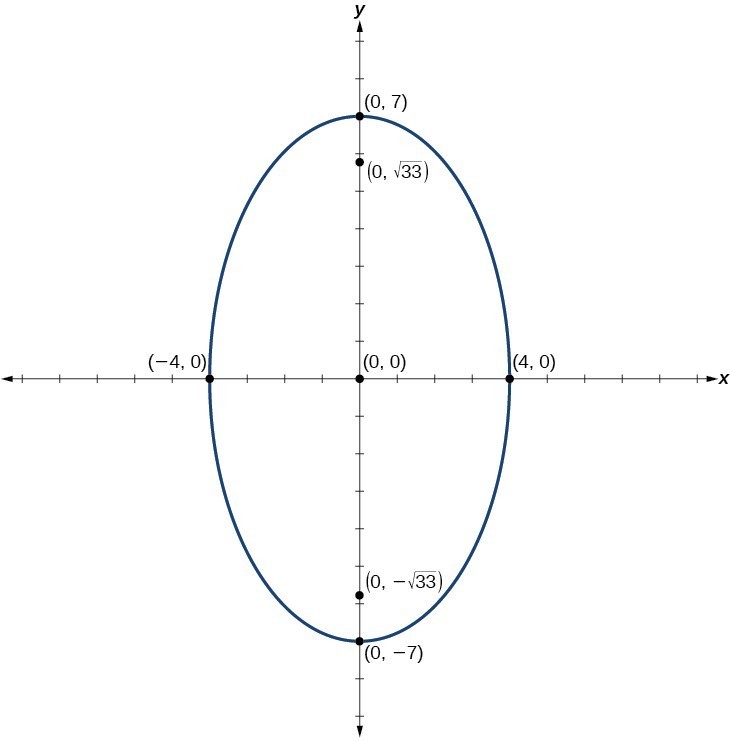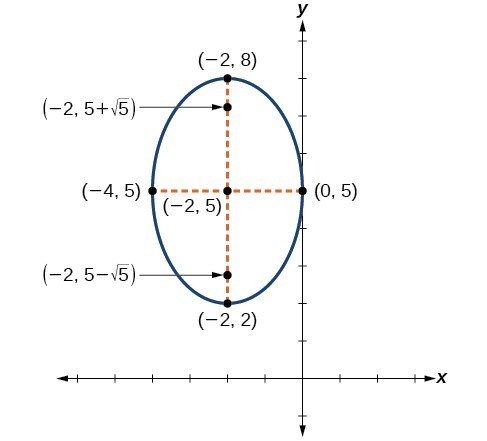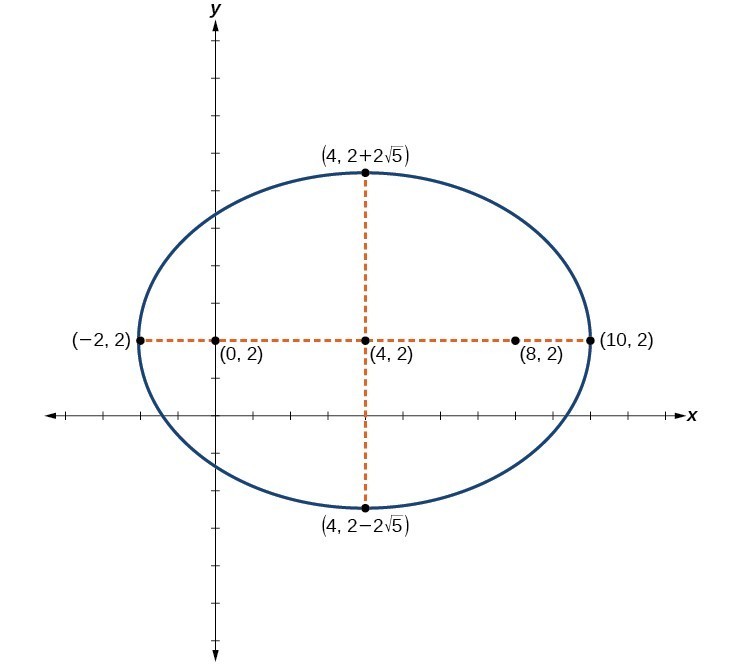Learning Outcomes
- Sketch a graph of an ellipse centered at the origin.
- Sketch a graph of an ellipse not centered at the origin.
- Express the equation of an ellipse in standard form given the equation in general form.
Just as we can write the equation for an ellipse given its graph, we can graph an ellipse given its equation. To graph ellipses centered at the origin, we use the standard form [latex]\dfrac{{x}^{2}}{{a}^{2}}+\dfrac{{y}^{2}}{{b}^{2}}=1,\text{ }a>b[/latex] for horizontal ellipses and [latex]\dfrac{{x}^{2}}{{b}^{2}}+\dfrac{{y}^{2}}{{a}^{2}}=1,\text{ }a>b[/latex] for vertical ellipses.
How To: Given the standard form of an equation for an ellipse centered at [latex]\left(0,0\right)[/latex], sketch the graph.
- Use the standard forms of the equations of an ellipse to determine the major axis, vertices, co-vertices, and foci.
- If the equation is in the form [latex]\dfrac{{x}^{2}}{{a}^{2}}+\dfrac{{y}^{2}}{{b}^{2}}=1[/latex], where [latex]a>b[/latex], then
- the major axis is the x-axis
- the coordinates of the vertices are [latex]\left(\pm a,0\right)[/latex]
- the coordinates of the co-vertices are [latex]\left(0,\pm b\right)[/latex]
- the coordinates of the foci are [latex]\left(\pm c,0\right)[/latex]
- If the equation is in the form [latex]\dfrac{{x}^{2}}{{b}^{2}}+\dfrac{{y}^{2}}{{a}^{2}}=1[/latex], where [latex]a>b[/latex], then
- the major axis is the y-axis
- the coordinates of the vertices are [latex]\left(0,\pm a\right)[/latex]
- the coordinates of the co-vertices are [latex]\left(\pm b,0\right)[/latex]
- the coordinates of the foci are [latex]\left(0,\pm c\right)[/latex]
- If the equation is in the form [latex]\dfrac{{x}^{2}}{{a}^{2}}+\dfrac{{y}^{2}}{{b}^{2}}=1[/latex], where [latex]a>b[/latex], then
- Solve for [latex]c[/latex] using the equation [latex]{c}^{2}={a}^{2}-{b}^{2}[/latex].
- Plot the center, vertices, co-vertices, and foci in the coordinate plane, and draw a smooth curve to form the ellipse.
Recall the square root property
With the [latex]{x}^{2}[/latex] term isolated, the square root propty states that:
[latex]\text{if }{x}^{2}=k,\text{then }x=\pm \sqrt{k}[/latex]
Don’t forget to take the plus or minus!
Example: Graphing an Ellipse Centered at the Origin
Graph the ellipse given by the equation, [latex]\dfrac{{x}^{2}}{9}+\dfrac{{y}^{2}}{25}=1[/latex]. Identify and label the center, vertices, co-vertices, and foci.
Try It
Graph the ellipse given by the equation [latex]\dfrac{{x}^{2}}{36}+\dfrac{{y}^{2}}{4}=1[/latex]. Identify and label the center, vertices, co-vertices, and foci.
https://ohm.lumenlearning.com/multiembedq.php?id=113386&theme=oea&iframe_resize_id=mom5
Example: Graphing an Ellipse Centered at the Origin from an Equation Not in Standard Form
Graph the ellipse given by the equation [latex]4{x}^{2}+25{y}^{2}=100[/latex]. Rewrite the equation in standard form. Then identify and label the center, vertices, co-vertices, and foci.
Try It
Graph the ellipse given by the equation [latex]49{x}^{2}+16{y}^{2}=784[/latex]. Rewrite the equation in standard form. Then identify and label the center, vertices, co-vertices, and foci.
Graphing Ellipses Not Centered at the Origin
When an ellipse is not centered at the origin, we can still use the standard forms to find the key features of the graph. When the ellipse is centered at some point, [latex]\left(h,k\right)[/latex], we use the standard forms [latex]\dfrac{{\left(x-h\right)}^{2}}{{a}^{2}}+\dfrac{{\left(y-k\right)}^{2}}{{b}^{2}}=1,\text{ }a>b[/latex] for horizontal ellipses and [latex]\dfrac{{\left(x-h\right)}^{2}}{{b}^{2}}+\dfrac{{\left(y-k\right)}^{2}}{{a}^{2}}=1,\text{ }a>b[/latex] for vertical ellipses. From these standard equations, we can easily determine the center, vertices, co-vertices, foci, and positions of the major and minor axes.
How To: Given the standard form of an equation for an ellipse centered at [latex]\left(h,k\right)[/latex], sketch the graph.
- Use the standard forms of the equations of an ellipse to determine the center, position of the major axis, vertices, co-vertices, and foci.
- If the equation is in the form [latex]\dfrac{{\left(x-h\right)}^{2}}{{a}^{2}}+\dfrac{{\left(y-k\right)}^{2}}{{b}^{2}}=1[/latex], where [latex]a>b[/latex], then
- the center is [latex]\left(h,k\right)[/latex]
- the major axis is parallel to the x-axis
- the coordinates of the vertices are [latex]\left(h\pm a,k\right)[/latex]
- the coordinates of the co-vertices are [latex]\left(h,k\pm b\right)[/latex]
- the coordinates of the foci are [latex]\left(h\pm c,k\right)[/latex]
- If the equation is in the form [latex]\dfrac{{\left(x-h\right)}^{2}}{{b}^{2}}+\dfrac{{\left(y-k\right)}^{2}}{{a}^{2}}=1[/latex], where [latex]a>b[/latex], then
- the center is [latex]\left(h,k\right)[/latex]
- the major axis is parallel to the y-axis
- the coordinates of the vertices are [latex]\left(h,k\pm a\right)[/latex]
- the coordinates of the co-vertices are [latex]\left(h\pm b,k\right)[/latex]
- the coordinates of the foci are [latex]\left(h,k\pm c\right)[/latex]
- If the equation is in the form [latex]\dfrac{{\left(x-h\right)}^{2}}{{a}^{2}}+\dfrac{{\left(y-k\right)}^{2}}{{b}^{2}}=1[/latex], where [latex]a>b[/latex], then
- Solve for [latex]c[/latex] using the equation [latex]{c}^{2}={a}^{2}-{b}^{2}[/latex].
- Plot the center, vertices, co-vertices, and foci in the coordinate plane, and draw a smooth curve to form the ellipse.
Example: Graphing an Ellipse Centered at (h, k)
Graph the ellipse given by the equation, [latex]\dfrac{{\left(x+2\right)}^{2}}{4}+\dfrac{{\left(y - 5\right)}^{2}}{9}=1[/latex]. Identify and label the center, vertices, co-vertices, and foci.
Try It
Graph the ellipse given by the equation [latex]\dfrac{{\left(x - 4\right)}^{2}}{36}+\dfrac{{\left(y - 2\right)}^{2}}{20}=1[/latex]. Identify and label the center, vertices, co-vertices, and foci.
How To: Given the general form of an equation for an ellipse centered at (h, k), express the equation in standard form.
- Recognize that an ellipse described by an equation in the form [latex]a{x}^{2}+b{y}^{2}+cx+dy+e=0[/latex] is in general form.
- Rearrange the equation by grouping terms that contain the same variable. Move the constant term to the opposite side of the equation.
- Factor out the coefficients of the [latex]{x}^{2}[/latex] and [latex]{y}^{2}[/latex] terms in preparation for completing the square.
- Complete the square for each variable to rewrite the equation in the form of the sum of multiples of two binomials squared set equal to a constant, [latex]{m}_{1}{\left(x-h\right)}^{2}+{m}_{2}{\left(y-k\right)}^{2}={m}_{3}[/latex], where [latex]{m}_{1},{m}_{2}[/latex], and [latex]{m}_{3}[/latex] are constants.
- Divide both sides of the equation by the constant term to express the equation in standard form.
recall complete the square
To write the equation of an ellipse in standard form, you’ll need to complete the square two times.
Given an expression of the form [latex]a\left(x^2+bx\right)[/latex], add [latex]\left(\dfrac{b}{2}\right)^2[/latex] inside the parentheses, then subtract [latex]a\left(\dfrac{b}{2}\right)^2[/latex] to counteract the change you made.
If completing the square on one side of an equation, you may either subtract the value of [latex]a\left(\dfrac{b}{2}\right)^2[/latex] from that side, or add it to the other to maintain equality.
Then factor the perfect square trinomial you created inside the original parentheses.
Example
[latex]\qquad a\left(x^2+bx\right)[/latex]
[latex]=a\left(x^2+bx+ \left(\dfrac{b}{2}\right)^2\right)-a\left(\dfrac{b}{2}\right)^2[/latex]
[latex]=a\left(x+ \dfrac{b}{2}\right)^2-a\left(\dfrac{b}{2}\right)^2[/latex]
Example: Graphing an Ellipse Centered at (h, k) by First Writing It in Standard Form
Graph the ellipse given by the equation [latex]4{x}^{2}+9{y}^{2}-40x+36y+100=0[/latex]. Identify and label the center, vertices, co-vertices, and foci.
Try It
Express the equation of the ellipse given in standard form. Identify the center, vertices, co-vertices, and foci of the ellipse.
[latex]4{x}^{2}+{y}^{2}-24x+2y+21=0[/latex]
https://ohm.lumenlearning.com/multiembedq.php?id=23514&theme=oea&iframe_resize_id=mom50







